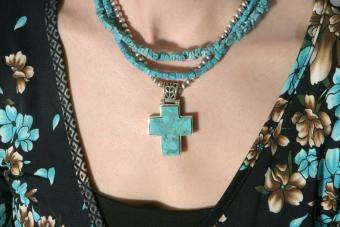
If you've ever seen a smooth, polished, smooth, flat oval gemstone that has an indentation in one of its surfaces, then you've seen a worry stone. These stones can be made from an array of colorful gems, rocks, and minerals, and many people use them to relieve stress.
What Is a Worry Stone?
A worry stone, sometimes called a thumb stone, is a crystal, gemstone, or rock that has been polished and shaped--either by a human or by nature--so it's easy to run your thumb smoothly across its surface. Some worry stones have been shaped with a slight indentation in the top surface to facilitate this action. The texture of the stone as well as the rubbing motion of the thumb is believed to relieve stress and anxiety. To use a worry stone, you hold it in either hand between your index finger and thumb and rub the pad of your thumb across the indented surface. It's a form of self soothing that many people find genuinely does relieve anxiety. You might also see larger worry stones called palm stones.
Physical Characteristics
Worry stones don't have to be any particular shape - any flat stone will do. However, some stones designed specifically for this purpose have the following physical characteristics:
- They are carved into a flat oval shape that's about 1 cm (⅓ inch) thick.
- They are usually a bit longer than an inch in diameter along the longest axis (about 3 cm) and about 3/4 an inch (2 cm) along the shorter axis.
- They have a smooth, flat surface.
- Some have a thumb shaped concave indentation along the top to allow you to easily run your thumb across it.
- They are tumbled and/or polished.
- They may be made from gemstone crystals or other types of rocks.

History and Cultural Uses
While the exact history of the worry stone is unclear, it is believed that the earliest examples were used in ancient Greece and in the Fertile Crescent. Examples of these stones have been found in mounds and ruins of these civilizations. The earliest worry stones were likely created in water, where the water shaped the stone into a flat rock.
A number of cultures have used or continue to use worry stones as a self-soothing mechanism. Some cultures with a history and practice of worry stone use include the following:
- People of Tibet rubbed flat stones as they chanted mantras.
- Celtic people rubbed flat pieces of Connemara marble to ease worry.
- Native North American cultures used them to ease worry and passed them down as treasured heirlooms through generations.
Do Worry Stones Work?
Many people believe worry stones relieve stress. So do they work? Anecdotal evidence from people who use them say that the repetitive motion is stress relieving and can be a meditative practice. But is there science to back it up? Other than user reports, no studies have been performed, so there's no hard, scientific evidence that the stones work for their intended purposes. However, much like similar stress relief items such as stress balls and fidget spinners, many people believe they do. Whether this is due to a placebo effect or for some other reason remains unproven.
How to Use a Worry Stone
Even in the absence of scientific evidence, rubbing a worry stone won't hurt and it might help you or your children during times of anxiety. To use a worry stone:
- Hold your hand to your side with the palm facing in, thumb on top, pinkie on bottom.
- Make a loose fist and place the worry stone on top of your index finger with the concave side up. Alternatively, hold larger stones in the palm of your hand.
- Rub the pad of your thumb forward and back, side to side, or in circles across the surface of the stone in the indentation.
You can do this when you feel stressed, or try these other uses:
- Use it as a point of focus when you perform a meditation. If your attention wanders, return it gently to the tactile sensation of the stone's surface beneath your thumb.
- Take a cue from Tibetans and speak a mantra with every rub of the stone, such as "Om" or "Peace."
- Give them to a fidgety kid when you need them to sit still for a bit. Make sure the stone is big enough it can't be swallowed and the child old enough they won't put it in their mouth.
- Keep a worry stone in a pocket at work and when you feel stressed, slip your hand in your pocket and rub its surface.
- If you are a fidgeter yourself, whether in church, at work, or in school, keep a worry stone in your pocket and rub it when you feel the urge to fidget.
- Rub a worry stone as you do deep breathing exercises just before bed in order to relax and prepare for sleep.

Materials
Worry stones are generally made from either crystal gemstones or rocks. They may be naturally formed or shaped by a lapidarist or artist. You may also find simulated worry stones made from synthetic materials, painted worry stones, engraved worry stones (often with a mantra or symbol), or even just naturally smooth, flat rocks used as worry stones. Choose one that speaks to you.
The cost of a worry stone will vary based on the type of gemstone it is made from, but generally they'll cost anywhere from a few dollars and up. Since these can be high-use items, choose a worry stone that is has a high hardness and low brittleness so it will hold up. Some minerals and rocks that make good worry stones include:
- River rock
- Agate
- Jasper
- All forms of quartz including clear, rose quartz, citrine, smoky quartz, and amethyst
- Chalcedony
- Lapis lazuli
- Granite
- Marble
Smooth Away Your Worries
While there's nothing magical about a worry stone, many people find using one is a relaxing activity that helps them focus, eliminates worry, and soothes or calms their mind. So if stress is getting to you, give a worry stone a try. For just a few bucks--or even for free if you find a rock on the beach you really like--you may find a new, soothing practice.







